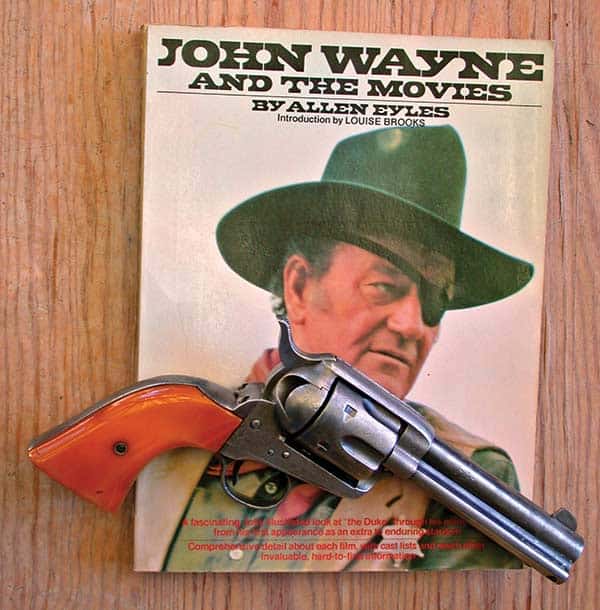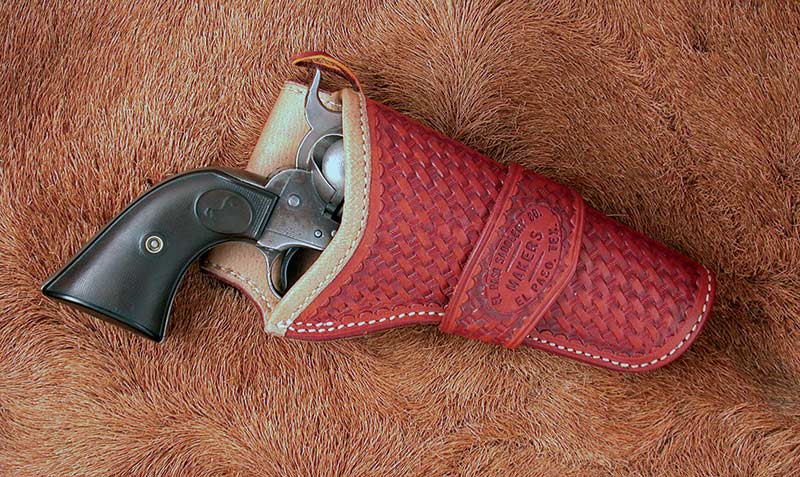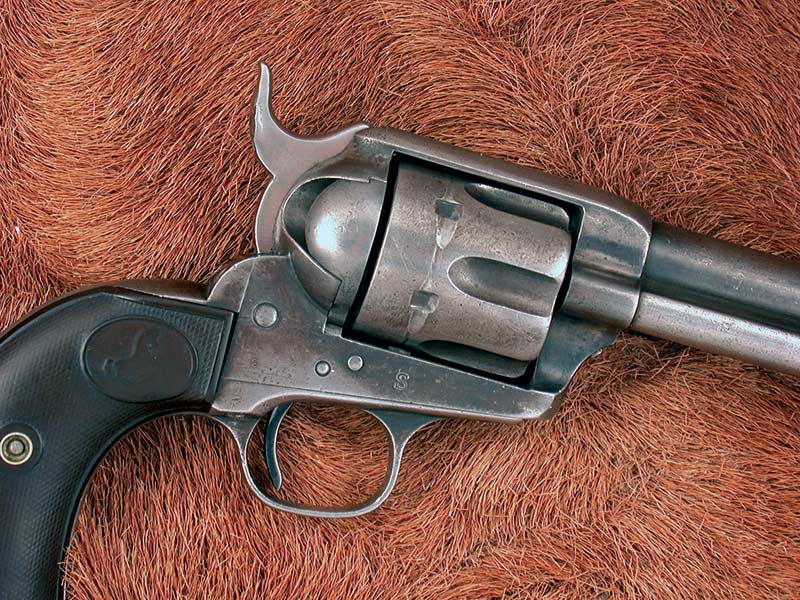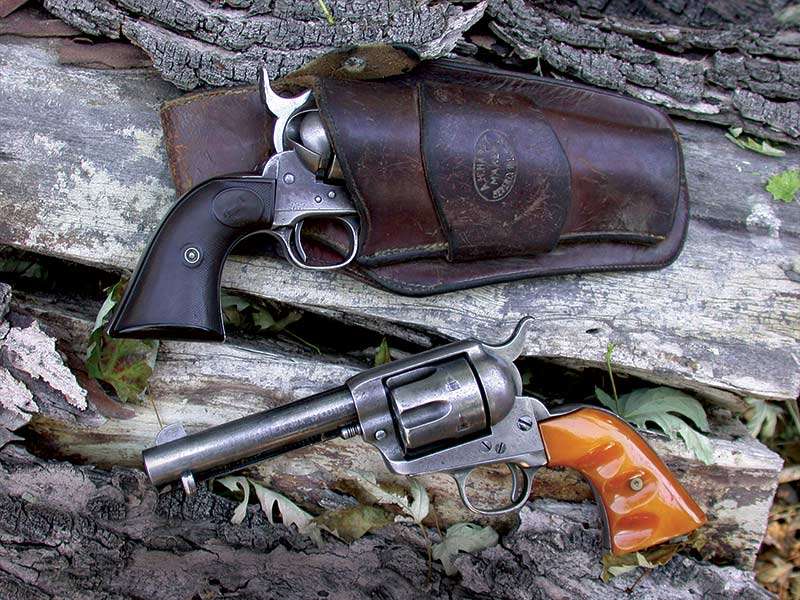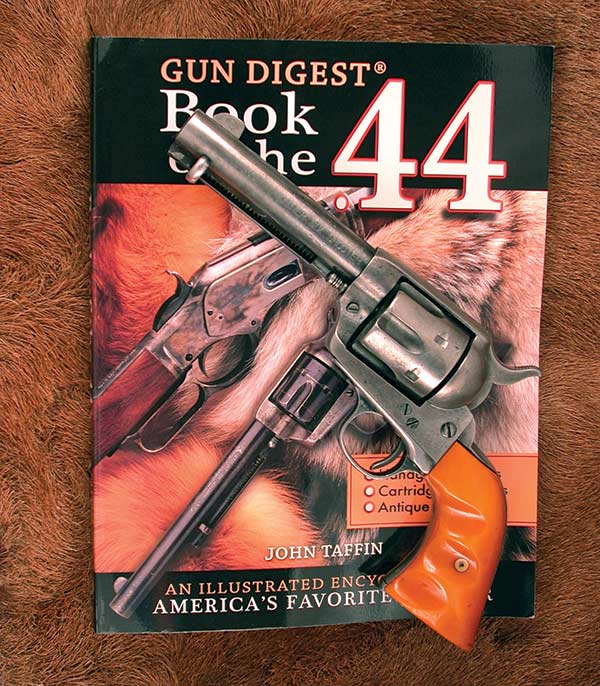The Sixguns Of John Wayne
“I mean to kill you or see you hang in Judge Parker’s court.” “That’s mighty big talk for a one-eyed fat man!” “Fill your hand you sunnovabitch!” And with those words Rooster Cogburn, with the reins in his teeth, twirling his Winchester in his right hand, and cocking the Colt in his left hand, charges into the Ned Pepper gang and wins his first and only Oscar for his real self, John Wayne. The movie was True Grit and Wayne said it was the first movie in which he played a character instead of himself. “You’ve gone to seed Rooster,” says John McIntyre in the sequel, but the pot belly and eye-patch will be forever linked to John Wayne as one of his best, perhaps the best film role of his 169-film career spanning more than 50 years from 1925 to 1976.
Depending upon the biographer consulted, Marion Michael Morrison — or Marion Robert Morrison — was born in 1907 or 1908 in Winterset, Iowa. His father was a pharmacist and due to bad health moved the family to California when Marion was five years old. The move was good for both father and son and young Marion attended Glendale High School where he starred on the football team. After being unable to win an appointment to Annapolis and a Navy career, he eventually secured a scholarship to USC and played in the Rose Bowl.
At the time, silent movie Western star Tom Mix arranged for summer jobs for USC football players and Morrison worked in the property department. He was spotted by John Ford, who hired him as an extra in what would be Morrison’s first film, Mother Machree, and set the stage for the future and some of the greatest films ever, John Ford Westerns.
As a youngster Morrison had a large dog named Duke, from which he received the nickname “Little Duke” and in his first movies he was known as Duke Morrison. Duke would appear in six more movies and was then hired by Raoul Walsh to play the scout in the epic Western, The Big Trail in 1930. Morrison arrived on set after two weeks of acting lessons and Walsh had to spend time washing away those lessons so he would be the natural person needed for the role. In later years Duke would say he never acted, but rather was just himself and we can thank Raoul Walsh for that.
Duke’s first Western film did not do well, however it gave him a new name and set the stage for a long line of “B” Westerns. Marion Morrison simply would not do, so Duke became John Wayne. During the 1930s John Wayne made a long string of, as he says, “Each film more forgettable than the last,” budget Westerns. In 1935 he starred as Stoney Brook in The Three Mesquiters movies and also began a long friendship with the man who was probably the greatest of all stunt men, Yakima Canutt. Not only did Canutt do many of the Duke’s stunts, he taught him how to stage fight scenes and also appeared as a heavy in many of Wayne’s and other’s budget Westerns.
Guns As Stars
With such a long career it’s easy to categorize John Wayne’s Western films in many ways. One of the easiest divisions is made by looking at the Colt Single Actions he used. Throughout most of his low-budget, make-‘em-fast B-Westerns his Single Action Army of choice was a 51⁄2″, nickel-plated, ivory stocked .38-40 or .44-40 carried in a fully carved belt and holster, sometimes Buscadero style with the holster hanging from a loop in belt. Others featured more of a Tom Three persons-style holster riding high on the belt. In either case John Wayne was appropriately armed and outfitted as a true B-Western movie hero. He may not have thought much of his B-Western roles, however he was the hero of countless numbers of young boys during the Depression era.
Throughout the 1930s he was stuck in the B-Westerns, however that was about to change. In 1939 he was chosen for the role of Ringo in Stagecoach, of the all-time great Westerns, which was his 65th film. This is one of the few Westerns he made without a Colt Single Action. His co-star in this movie was the first appearance of a Winchester Model 92 with the large loop lever now forever
known as the John Wayne Lever. When the Duke stood in front of the stage to Lordsburg and swung that rifle a new phase of his career began. The stunt man in Stagecoach was once again Yakima Canutt, who performed the memorable stunt of falling from the running team of horses, going under the moving coach, grabbing the back of the coach and coming back up on top. He did many such stunts, making John Wayne look very good and providing grand excitement. In later years, Canutt was replaced by the Duke’s standard stunt man and stand-in, Chuck Roberson.
Stagecoach was a definite hit and would launch another phase of Wayne’s career, however he was still under contract for several more B-Westerns before he left them forever. Better parts came along beginning with Tall In The Saddle in 1944. This combination mystery and Western has one of my all-time favorite John Wayne scenes as he faces the bad guy in the middle of street and says, “Touch that gun and I’ll kill you!”
With this movie we see his leather and sixgun have changed. The flamboyancy of B-Westerns was no longer needed and the holster, made by Cap Hardy or Ed Bohlin, was of plain leather and of the style Wayne would wear in the rest of the films; a Tom Three persons style with a longer drop loop. The sixgun is now a standard finished Colt Single Action with black gutta percha grips. The style would be carried well into the 1950s and returned to in his 126th film in the 1960s, a black and white feature, The Man Who Shot Liberty Valance.
Producer
In 1947 Wayne not only starred in, but also produced, his first film, Angel And The Badman. This is the earliest John Wayne Western I remember firsthand. I was eight years old at the time and along with my five-year-old cousin walked several miles to see John Wayne as gunfighter Quirt Evans. One year later I would ride the bus to town by myself to see The Three Godfathers, Wayne’s first color western. As I think back on these wonderful growing up years it pains me to realize how times have changed. Not only do young kids no longer have heroes, at least the right kind, there aren’t many places left in the country where young kids can travel safely on their own.
Duke would soon become a top box office draw. The John Wayne/John Ford Western Trilogy of Fort Apache, Rio Grande, and She Wore A Yellow Ribbon saw Wayne cast not as a cowboy or gunfighter but rather a member of the United States Cavalry on the frontier, a role he would return to several times in the future. These three pictures were among the last of his black and white features, and all of his future Westerns except one would be big budget color features.
In 1964, Wayne, who had been a chain smoker most of his life, was found to have cancer. Instead of trying to keep it secret he went public to encourage others. He survived, however lost a lung in the process. Films made after this time show some of the effects of cancer as the stunt man and stand-ins become more obvious, however what he is still able to do himself is most remarkable.
Different Guns
The third phase of John Wayne’s sixguns begins in the late 1950s and early 1960s as he begins carrying the Colt Single Action most of us are familiar with, as well as what has now become typical John Wayne leather. The belt is now a folded-over suede leather money belt, and the holster, which is now offered by El Paso, is a higher riding rendition of an earlier Cap Hardy holster. His sixgun, which he wrongfully called a “Navy Colt” in at least two movies, is a 43⁄4″ Colt Single Action Army, or more correctly a Frontier Six Shooter chambered in .44-40. On the screen it appears to be nickel plated with yellowed ivory stocks. In reality the finish is well worn and may have originally been nickel or blue, and the yellowed ivory stocks with finger grooves are actually made of a tough pre-micarta synthetic known as Catalin. These grips were made by a Texas gun shop owner by the name of Maurice Scarlock who worked in San Antonio and El Paso in the 1920s and 1930s. They are available today from Buffalo Brothers.
In 1969, with only one lung, and now in his early 60s, pot belly and all, John Wayne put on an eye patch and became Rooster Cogburn in a memorable performance. Rooster was a man with true grit and Hollywood finally recognized his contributions.
After True Grit, John Wayne would make some of his most enjoyable and best Western films: Chisum, Rio Lobo, Big Jake (“I thought you was dead!”), The Cowboys, The Train Robbers, and Cahill, U.S. Marshall. In Big Jake John Wayne was teamed with Maureen O’Hara as he had been in The Quiet Man, Rio Grande and McClintock; every theme was the same, that of the war between the sexes.
I won’t argue the fact but Maureen O’Hara was certainly the most beautiful actress to ever appear on film. After the Duke’s death she led the effort, along with Elizabeth Taylor, to have a Congressional Medal issued to celebrate Wayne; it simply said “JOHN WAYNE, AMERICAN” as he was a true American patriot.
In 1971 John Wayne was chosen by our sister publication, GUNS, as their first “Man Of The Year” and presented with a 71⁄2″ ivory stocked .45 Colt Single Action. The last two films made by John Wayne rank way up on my list of his favorites. My son-in-law came over last night and asked to watch a John Wayne movie. I plugged in the 1975 Rooster Cogburn with the Duke paired with a memorable performance by Katharine Hepburn in what is essentially a re-make of The African Queen. This film would be the last time Wayne used his 43⁄4″ .44-40 “ivory-stocked” Colt Single Action.
The Last Go
John Wayne had one more film left in him. In 1976, now nearly 70 years old, his 169th and last film would be The Shootist which tells a story of an aging gunfighter dying of cancer. His sixgun, actually sixguns, are also different. He uses two of them, one fully engraved; and, at least according to very reliable sources, they are not Colts but actually Great Westerns presented to him by Great Western in the 1950s. Wayne is pictured in Sixguns By Keith (1955) with his pair of Great Westerns.
John Wayne, as my two other lifetime heroes Theodore Roosevelt and Elmer Keith, was uniquely American and a true one-of-a-kind. We shall not see their like again. I have been privileged to have four guns used by John Wayne in many movies on hand for several months. They are a Remington .44 converted to cartridges and used by him in the opening scenes of another grand B&W film, Red River; a Winchester Model 1892 .44-40 with the large loop lever; and two Colt Single Action Army models, both with 43⁄4″ barrels. Neither sixgun has any finish left. The oldest, in the 125,000 serial number range, dates to 1888. It has no caliber markings, and wears the standard gutta percha grips. The hammer has been modified for easier fanning as used by Wayne as Tom Doniphan in The Man Who Shot Liberty Valance. The only cartridge I can find which will chamber in the sixgun is a .44 Russian.
The second sixgun, dating back to 1896, and as noted is a 43⁄4″ .44-40 Colt Frontier Six Shooter with yellowed stocks, he used in many movies from the 1950s through the 1970s. All of these guns originally belonged to Stembridge Rentals which rented guns to the movies for nearly 60 years. They closed their doors in 1999 and all guns were sold off. Fortunately they kept very accurate records on which guns were loaned to who and used in which movies.
The guns pictured now belong to Al Frisch. If you are interested in old movie guns and history contact Al Frisch at 24907 Meadview Ave., Newhall CA 91321, (661) 259-9789. He also has an excellent DVD video of a modern B Western he has produced which has an extra bonus presentation of many of the movie guns hosted by himself, Phil Spangenberger and Buck Taylor. Both the movie, Vengeance Trail, and the extra added feature Star Guns of Western Films are most enjoyable and guaranteed to take the viewer back in time.
When asked how he would like to be remembered, Wayne said “Feo, Fuerte, y Formal” which translated from the Spanish is “He was ugly, was strong, and had dignity.” Not a bad epitaph.
Subscribe To American Handgunner

Get More Revolver Content Every Week!
Sign up for the Wheelgun Wednesday newsletter here:


